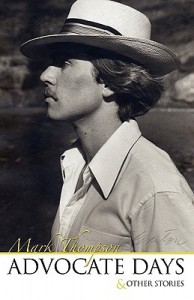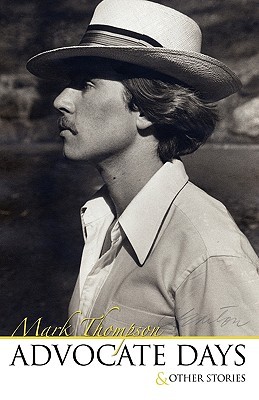 Advocate Days & Other Stories
Advocate Days & Other Stories
by Mark Thompson
Queer Mojo. 165 pages, $24.95
IF WE DATE the modern gay movement from the end of World War II or thereabouts, we’re about 65 years in. Writer Mark Thompson has been involved in chronicling queer history and culture for more than half of that time, first as a student journalist at San Francisco State and then working at The Advocate during its formative years in the mid-70’s until the early 90’s. Gay history is still being told, and Thompson’s conversational, short volume Advocate Days & Other Stories adds significant information to what we know. Despite the fact that there are some tough truths in this book and that it covers some dark times, Thompson’s overall outlook is affirmative, and his writing is for the most part effective.
“Advocate Days” is part one of the book, telling of Thompson’s first-hand, extended involvement in gay journalism. For a kid from Carmel, California, reading all sixteen pages of the March 1968 edition of The Advocate was a revelation. “The publication I held in my hands was telling me something different—and for the first time.” This wide-eyed enthusiasm is characteristic of Thompson’s style in these vignettes. There’s little vitriol or bitterness and much peace-making in this story of The Advocate’s early days in San Francisco, which finds Thompson working with people like Randy Shilts and the notorious David Goodstein. If you’ve seen Milk, you’ll enjoy much of this book as supplementary material from an eyewitness. “Harvey was our hero, a working-class star who became a martyr and then a myth. When in doubt, print the myth.” A little de-mythologizing here is a useful corrective to that story.
The Advocate proclaimed 1977 “the year of the gay”—and then came Anita Bryant, followed closely by John Briggs and his homophobic referendum in California. The rise of the new right gets some attention here, which feels timely, given that they’re still around and still the major obstacle in our path on every gay rights issue.
As gay politics became more established over the next few years, Thompson and his friends began noticing another change, even before AIDS had been identified. To Thompson, San Francisco was “a small city. I was always good at remembering faces on the street. … I started to notice the absence of men I had known.” He quotes an editorial by Goodstein from the summer of 1980, after the Democratic National Convention, saying: “I foresee the next ten years to be the best in the history of humankind.” As Thompson observes, “Then tragedy struck, right where we worked.” Colleagues at the magazine began to get sick and die, the city and history changed, but not in the ways that Goodstein had predicted.
A few years later, The Advocate moved to Los Angeles, and Thompson went with it. A die-hard lover of the City by the Bay, he did not have an easy transition, but he managed. The magazine’s circulation reached nearly 100,000 in the early 90’s, but times and philosophies had changed, so Thompson left his job. His final act, though, was to compile a book titled The Long Road to Freedom, a sort of “greatest hits” of the magazine that was set to debut at a New York party in 1994 on the occasion of the twenty-fifth anniversary of Stonewall. But the book didn’t make it to the party. “People started to arrive, but there were no books on display anywhere. For reasons known only to the powers-that-be, The Advocate’s own history was not going to be exhibited on that historic night. Talk about self-sabotage!”
This tale of self-sabotage is illustrative of Thompson’s view of contemporary gay history—a two-steps-forward, one- (or two-) step-backward situation. In some ways, he accounts for that as a psychologist, which is where his career carried him during the decade after he left the magazine. He suggests that “oppression sickness,” which is related to the damage done to queer folks by a homophobic culture, “is one of the gay community’s most vexing problems, and one that is often the first to go undiagnosed, still to this day.”
The second half of Thompson’s book is a collection of shorter memoirs, including stories about the filmmaker and poet James Broughton, gay pioneers Harry Hay and John Burnside, the writer Paul Monette, and a few other notable figures. The final tale, co-written with his longtime partner Malcolm Boyd, is called “Charmed, I’m Sure!” It’s a dialogue on love and on making a life together. For them love is “at once an act of faith and utter devotion” and, they add, “there really is no other better reason for living.” They become each other’s best advocate, which underscores the book’s motif—that we would all do well to advocate for what we believe in, including ourselves and each other.






